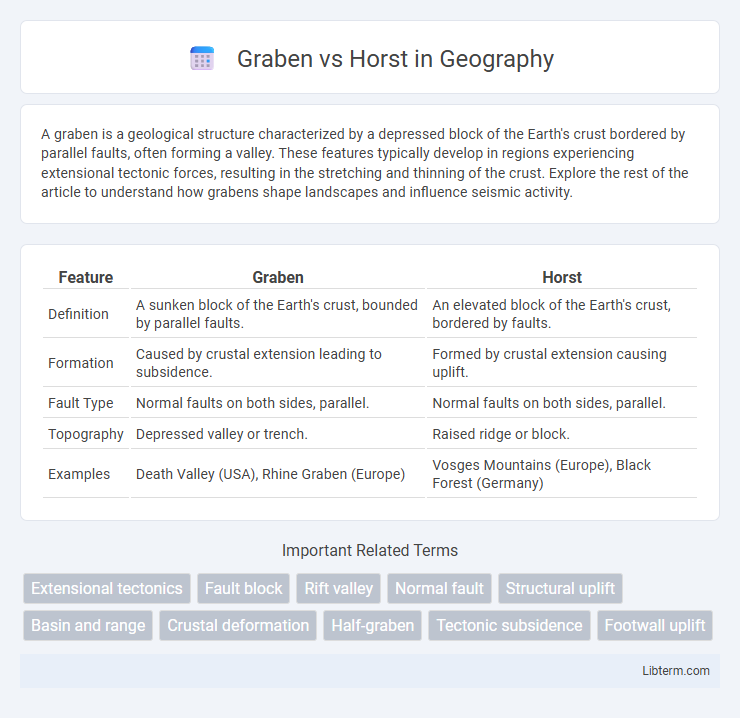A graben is a geological structure characterized by a depressed block of the Earth's crust bordered by parallel faults, often forming a valley. These features typically develop in regions experiencing extensional tectonic forces, resulting in the stretching and thinning of the crust. Explore the rest of the article to understand how grabens shape landscapes and influence seismic activity.
Table of Comparison
| Feature | Graben | Horst |
|---|---|---|
| Definition | A sunken block of the Earth's crust, bounded by parallel faults. | An elevated block of the Earth's crust, bordered by faults. |
| Formation | Caused by crustal extension leading to subsidence. | Formed by crustal extension causing uplift. |
| Fault Type | Normal faults on both sides, parallel. | Normal faults on both sides, parallel. |
| Topography | Depressed valley or trench. | Raised ridge or block. |
| Examples | Death Valley (USA), Rhine Graben (Europe) | Vosges Mountains (Europe), Black Forest (Germany) |
Introduction to Graben and Horst
Graben and Horst are fundamental geological structures formed by tectonic forces causing block faulting within the Earth's crust. A graben is a depressed block of land bordered by parallel faults, resulting in a valley or trough, while a horst is an elevated block flanked by faults, often forming a ridge or mountain. These features are key indicators of extensional tectonics and crustal deformation.
Geological Definitions of Graben and Horst
A graben is a depressed block of the Earth's crust bordered by parallel faults, typically formed by extensional tectonics causing the central section to sink relative to surrounding blocks. In contrast, a horst is an elevated block that remains stationary or is uplifted between two graben faults, bounded by normal faults dipping away from the center. Both structures are key features in rift zones and continental extension, illustrating crustal deformation through faulting processes.
Formation Processes of Graben and Horst
Graben and horst are geological structures formed by extensional tectonic forces causing the Earth's crust to fracture and move along normal faults. A graben forms when a block of crust drops downward between two parallel faults due to the stretching and thinning of the crust. In contrast, a horst develops as an uplifted block bounded by faults, remaining elevated relative to the subsiding graben blocks.
Tectonic Settings for Graben vs Horst
Graben structures form in extensional tectonic settings where the Earth's crust is stretched, causing blocks to sink between normal faults. Horsts develop in similar extensional regimes but represent uplifted blocks bounded by normal faults, often adjacent to grabens. These features are characteristic of rift zones and continental divergence, reflecting differential vertical movements along fault systems.
Key Structural Differences: Graben vs Horst
Graben and horst are key structural features in extensional tectonic regimes, representing opposite fault block formations. A graben is a down-dropped block bounded by two normal faults dipping towards each other, forming a trough-like depression, while a horst is an uplifted block bounded by normal faults dipping away from each other, creating an elevated ridge. These differences in movement and fault orientation result in distinct topographical variations critical for understanding basin development and mountain building processes.
Examples of Famous Grabens Worldwide
Famous grabens worldwide include the East African Rift Valley, which stretches over 3,000 kilometers through countries like Ethiopia and Kenya, showcasing active continental rifting. Another prominent example is the Rhine Graben in Europe, extending through Germany and France, known for its tectonic activity and seismic events. The Dead Sea Rift between Israel and Jordan is a significant graben characterized by its deep depression and rich geological history.
Notable Horst Structures Around the Globe
Notable horst structures around the globe include the Harz Mountains in Germany, characterized by uplifted blocks bordered by faults, and the Vosges in France, known for their steep, rugged terrain. The Black Forest in southwestern Germany also exemplifies a prominent horst, formed by tectonic forces that elevated the block relative to adjacent grabens. These horst formations reveal significant insights into crustal extension and fault dynamics within rift zones worldwide.
Importance of Graben and Horst in Earth Sciences
Graben and horst structures are crucial for understanding tectonic processes and crustal deformation in Earth sciences. Their presence reveals zones of crustal extension and fault activity, influencing regional geology and seismic risk assessment. Studying these formations aids in natural resource exploration, such as hydrocarbons and minerals, by identifying sedimentary basins and structural traps.
Environmental and Economic Impacts
Graben formations often lead to the creation of basins that can accumulate water, supporting diverse ecosystems and enabling agricultural development, while their geological instability may increase the risk of earthquakes and flooding, impacting local communities. Horsts, characterized by elevated blocks, can create natural barriers affecting weather patterns and water flow, which influence soil erosion and vegetation distribution, potentially limiting land use but offering opportunities for mining valuable mineral deposits. Both structures significantly shape regional environmental dynamics and economic activities through their influence on resource availability and natural hazard susceptibility.
Summary: Graben vs Horst Comparison
Graben and horst are geological structures formed by tectonic forces causing the Earth's crust to fracture and shift. A graben is a lowered block bounded by parallel faults, creating a valley or depression, while a horst is an elevated block flanked by faults, forming a ridge or plateau. These formations are critical in understanding fault systems, seismic activity, and landscape evolution in rift zones.
Graben Infographic

 libterm.com
libterm.com